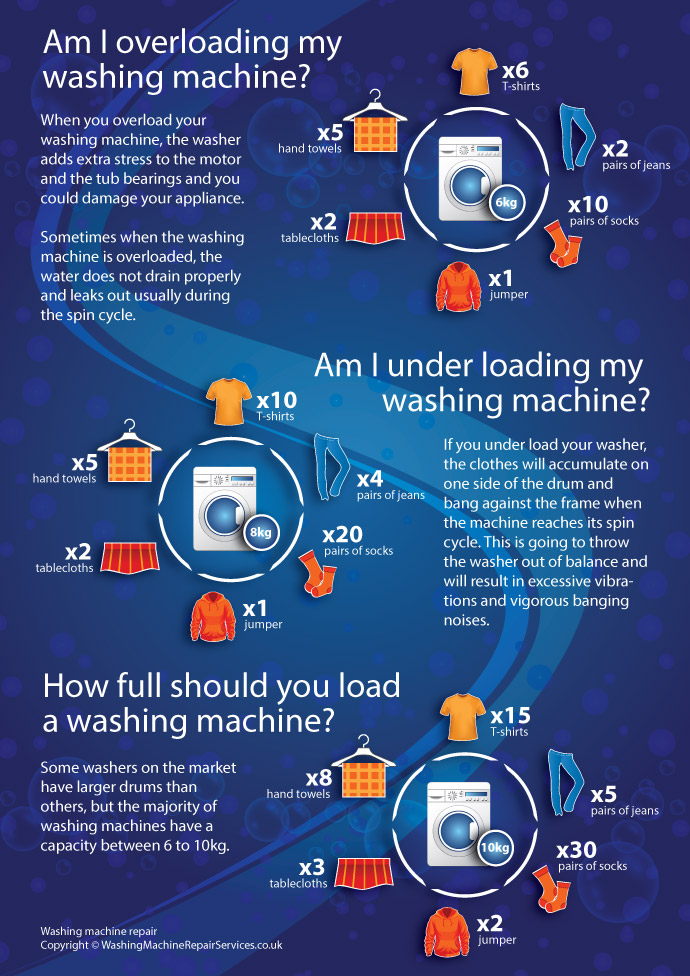Your washing machine is overloaded if it struggles to start the cycle or the laundry is tightly packed with no room to move. An overloaded machine may make unusual noises or vibrations during operation.
Overloading a washing machine can lead to several problems impacting both the appliance and your laundry results. Striking the right balance ensures clean clothes and prolongs the life of the machine. An optimally loaded washer operates efficiently, with enough space for clothes to move freely in the water, which aids in effective cleaning and reduces wear and tear on the machine.
Knowing the signs of an overloaded washing machine not only helps in maintaining the appliance but also in preventing potential damage to your garments. Regularly monitoring the load ensures your washing machine runs smoothly and your clothes come out clean and undamaged.
Table of Contents
Signs Of Overloaded Washing Machine
Knowing the signs of an overloaded washing machine can save it from costly damage. A well-loaded machine cleans efficiently and keeps your laundry routine on track. Learn to spot the signs of an overloaded washer to protect its lifespan.
Unusual Noises
Clanking and banging sounds during a wash cycle are big red flags. These noises suggest that clothes cannot move freely. When you hear such sounds, promptly pause the cycle. Remove items until the washer sounds normal when restarted.
Vibration And Shaking
Excessive vibration and shaking indicate an overloaded machine. A washer should hum steadily, without much drama. Bulging sides or a lid that won’t close are visual cues. Do a balance check: reduce the load if the washer rocks when pushed lightly.
- Machine pauses or stops: The washer might halt if struggling with weight.
- Sopping wet clothes: Overloading hinders the spin cycle, leaving clothes wet.
- Longer wash times: A heavy load might extend cycle times, consuming more energy.
Always refer to your washer’s manual for ideal load sizes. Following these tips will ensure peak performance and longevity for your machine.

Credit: www.washingmachinerepairservices.co.uk
Effects Of Overloading
Overloading creates a negative effect on your washing machine. An overloaded machine struggles to clean your clothes properly. Signs of damage may appear on fabrics. It can also lead to a reduction in machine efficiency over time. Understanding these effects helps maintain your laundry and machine’s longevity.
Damaged Clothing
Too many clothes in a washing cycle can cause several issues:
- Items become tangled or stretched.
- Zipper and buttons may snag and rip fabrics.
- Excessive friction can weaken cloth fibers.
This can turn a favorite shirt or a pair of jeans into rags. Always check the recommended load size to prevent these issues.
Uneven Cleaning
An overloaded drum prevents clothes from moving freely. Consequently, you’ll notice:
- Soap residue on garments.
- Dirt marks even after a wash cycle.
- Odors that linger on clothing.
To ensure a thorough cleanse, give clothes room to tumble. A tip is to fill the drum to about three-quarters for the best results.
Prevention And Solutions
Overloading a washing machine can cause wear and tear. It also leads to unsatisfying wash results. To prevent this, two crucial steps are necessary. These ensure a long-lasting and efficient washing experience.
Follow Manufacturer’s Guidelines
Check your machine’s manual for capacity instructions. These guidelines come from the people who built your washer. Sticking to them is smart. It helps avoid any laundry day mishaps. Manuals often list weights for laundry loads. These weights help you judge how much your clothes weigh.
Use Correct Water Level
Choosing the right water level for your laundry is key. Machines typically have settings like small, medium, and large. These match load sizes. A correct match means better cleaning and less strain on your machine. Unsure about the right level? Use your manual. It has the answers.
Tip | Description |
|---|---|
Check Capacity | Consult your manual for maximum weight. |
Balance Clothes | Spread clothes evenly in the drum. |
Water Settings | Match water level to your load size. |
- Don’t guess the capacity—know it.
- Distribute clothes evenly in the drum.
- Use the manual to select water settings rightfully.
Organize The Load
Load organizing is essential for an effective wash. Knowing how to do it right can save you from the hassle of an overloaded machine. Let’s plunge into the details of how to organize your laundry correctly.
Sorting By Fabric Type
Proper sorting is the first step to prevent overloading. Group your clothes based on fabric type. This not only protects delicate items but also assists in evenly distributing the load in the drum.
- Heavy Items: Jeans, towels, and heavy cottons.
- Light Items: Linens, synthetics, and delicate fabrics.
Arranging Evenly
Laying out your clothes evenly in the drum is essential. An uneven load can throw the machine off balance.
- Place larger items at the bottom.
- Add smaller items on top to fill gaps.
- Ensure no item sticks to one side of the drum.
Maintain a balance by spreading the load uniformly. This prevents strain on the motor and ensures a smooth cycle.
Also Read: Facing Issues With Washing Machine Belt?
Maintenance And Inspection
Maintaining your washing machine ensures longevity and efficiency. Regular inspections prevent overloading. Overloading can damage your machine and clothes. Recognize overloading signs for a happier laundry day.
Regular Cleaning Of Filters
Clean filters keep your machine running smoothly. Lint and debris in filters signal possible overloads. Follow these steps:
- Turn off and unplug the washing machine.
- Locate the filter cover (refer to the manual).
- Remove and gently clean the filter under running water.
- Check for any debris inside the filter housing.
- Replace the filter and cover.
Perform this task monthly to prevent issues.
Balancing The Drum
An unbalanced drum suggests overloading. Listen for loud noises or the machine moving during operation. Check the drum:
- Ensure the washing machine is off.
- Open the door and rotate the drum with your hand.
- Feel for resistance or wobbles.
- Inspect for even weight distribution with a level.
- Adjust the load if the drum seems off-balance.
Repeat this inspection every few months. Proper balance reduces wear on your machine’s components.

Credit: www.ariel.co.uk
Professional Assistance
Professional Assistance is necessary when you face washer overload symptoms. Expert help ensures your appliance operates efficiently.
Consulting A Technician
If your washing machine shows signs of struggle, it’s time to consult a technician. A professional can assess your washer with precise tools.
- Technicians identify overload signs and machine damage.
- They provide valuable advice on load limits.
- Experts offer tips to prevent future overloads.
Seeking Maintenance Services
Regular maintenance services preserve your washer’s health.
- Service providers inspect washer balance and alignment.
- They clean filters and check for blockages.
- Professionals examine the drum, ensuring optimal performance.
Timely maintenance avoids the risks of overloading your machine. Remember to always opt for authorized services for your appliance brand.
Additional Tips
Have you ever questioned if your washing machine is too full? Knowing the limits can extend its life and ensure clothes come out clean. Here are practical tips to avoid mishaps:
Avoiding Overstuffing
An overstuffed washer works harder, risking damage to the machine and garments. Follow these steps:
- Check the manual: It often lists the maximum load.
- Use the palm rule: If you can’t fit your palm, it’s too full.
- Balance items: Mix large and small pieces for even washing.
Checking For Movement
To ensure a good wash, clothes need to move freely. This is how to check:
- Open the lid mid-cycle.
- Observe the tumbling: Clothes should circulate without getting stuck.
- If they’re not moving, remove some items. This will improve washing and reduce strain on the machine.

Credit: www.houzz.com
FAQ
What Are Signs Of An Overloaded Washing Machine?
An overloaded washing machine may exhibit several signs, including difficulty turning the drum, excessive noise, and an unbalanced spin cycle. Clothes may also come out still dirty or excessively wet, indicating they haven’t been adequately washed or spun.
How Much Laundry Can A Washer Handle?
The capacity of a washing machine varies by model, but a standard washer can generally handle between 6 to 9 pounds of laundry per load. Consult your machine’s manual for the specific capacity and load guidelines to prevent overloading.
Can Overloading Damage The Washing Machine?
Yes, overloading a washing machine can cause significant damage. It puts extra strain on the motor, drum bearings, and suspensions, leading to costly repairs or a shortened lifespan for the machine.
How Do You Properly Load A Washer?
To properly load a washer, evenly distribute clothes around the drum without packing them too tightly. Follow the recommended load size as per the manufacturer’s instructions and ensure not to exceed the stated weight limit.
Final Words
Determining an overloaded washing machine is straightforward. Listen for unusual noises, check for unbalanced loads, and observe the machine’s performance. Your laundry routine will benefit from this awareness. Proper load sizes extend appliance life and improve efficiency. Remember, a well-maintained washer serves best!



